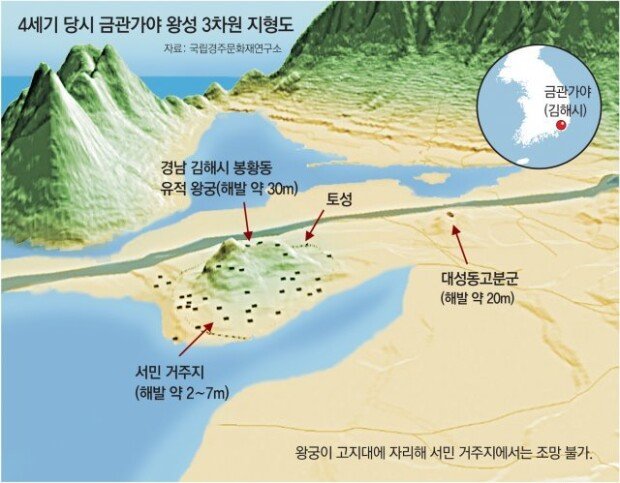Palace of Geumgwan Gaya built on hillside for showing dignity
Palace of Geumgwan Gaya built on hillside for showing dignity
Posted February. 14, 2022 07:47,
Updated February. 14, 2022 07:47

It was revealed in a study based on Geographic Information System (GIS) that the site of palaces in the Geumgwan Gaya era was located 30 meters above sea level, not visible from residential areas of ordinary folks. The ruling class represented their higher social status spatially. Likewise, the site of Wolseong Palace built around the same time during the Silla kingdom in Gyeongju, North Gyeongsang Province, turned out to be positioned higher than where rank-and-filers resided.
At an academic conference held by the Department of Korean History of Seoul National University on Thursday, researcher Kang Dong-seok at the Gyeongju National Research Institute of Cultural Heritage presented a thesis titled “GIS-based Restructuring of Ancient Landscapes” to 3D-analyze the presumed remains of a palace in Bonghwang-dong and tombs in Daeseong-dong, Gimhae. The GIS builds up a database on geological data of ancient times based on old maps, ancient books and archeological materials. This research technique is assessed to make it easy to take a look at political, social and economic backgrounds of spaces during an era by visualizing text-based historical materials.
Kang classified 48 historical sites of Geumgwan Gaya spotted around Bonghwang-dong and Daeseong-dong in Gimhae as palaces, residential areas for ordinary people, farmlands, etc. Based on the ground surface in the 4th century, his team compared and analyzed heights above sea level. It was found that the palace on top of a hill 30 meters above sea level was not seen from a residential zone for ordinary citizens scattered at 2 to 7 meters above sea level. The royal tombs in Daeseong-dong turned out to be situated 20 meters above sea level. By contrast, a panoramic scenery of the palace used to be visible from the Haebancheon basin that led to the access road to the palace, which must have shown its dignity and majesty to external visitors such as overseas envoys.
“With the place not seen by the public, the ruling class must have intended to cement the hierarchal system and strengthen royal power,” according to Kang. “The palace was used as a landmark to impress external visitors who accessed Geumgwan Gaya by sea by demonstrating its political authority and status.” Similarly, there was a 20-meter gap in height between Wolseong Palace on the hillside of the center of Gyeongju and residences of ordinary people on the flatland. Kang explained that the established in Silla also enjoyed their higher social status and authority by living in a higher positioned neighborhood than the public.
always99@donga.com
Headline News
- Harris ‘first female president’ vs. Trump ‘again 2016’
- N. Korea builds 11-meter rampart after road demolition
- Democratic Party eventually agrees to abolish financial investment income tax
- Drug smuggling is seized twice a day on average this year
- Surrounded by ‘uniforms,’ NHL’s first female coach ‘time-out’







